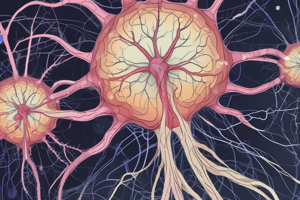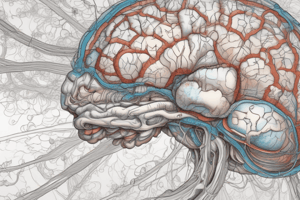Podcast
Questions and Answers
What are the three main areas that the central nervous system develops into?
What are the three main areas that the central nervous system develops into?
- Forebrain, Midbrain, and Hindbrain (correct)
- Cortex, Medulla, and Spinal cord
- Cerebrum, Cerebellum, and Brainstem
- Telencephalon, Diencephalon, and Myencephalon
Which part of the forebrain is vital for olfaction?
Which part of the forebrain is vital for olfaction?
- Rhinencephalon (correct)
- Neopallium
- Basal ganglia
- Telencephalon
What structure develops from the tail end of the neural tube?
What structure develops from the tail end of the neural tube?
- Thalamus
- Brainstem
- Cerebellum
- Spinal cord (correct)
Which part of the midbrain is responsible for visual processing?
Which part of the midbrain is responsible for visual processing?
Which area of the hindbrain includes the pons?
Which area of the hindbrain includes the pons?
What is one of the overall functions of the nervous system?
What is one of the overall functions of the nervous system?
In what way do the nervous and endocrine systems differ?
In what way do the nervous and endocrine systems differ?
Which part of the central nervous system is responsible for the integration of sensory information?
Which part of the central nervous system is responsible for the integration of sensory information?
Which division of the nervous system is responsible for sensing and transmitting sensory information?
Which division of the nervous system is responsible for sensing and transmitting sensory information?
What is the primary function of the processing division within the nervous system?
What is the primary function of the processing division within the nervous system?
Which region of the brain is NOT part of the brain stem?
Which region of the brain is NOT part of the brain stem?
Which root of the spinal nerve is associated with sensory nerves?
Which root of the spinal nerve is associated with sensory nerves?
What forms the link between the central nervous system (CNS) and all organs and systems of the body?
What forms the link between the central nervous system (CNS) and all organs and systems of the body?
What is the primary function of the myelin sheath as perceived by some researchers?
What is the primary function of the myelin sheath as perceived by some researchers?
Which zone of the neuron is responsible for initiating the action potential?
Which zone of the neuron is responsible for initiating the action potential?
How does the diameter of a nerve fiber affect its conduction velocity?
How does the diameter of a nerve fiber affect its conduction velocity?
What classification system is used by Erlanger and Gasser for nerve fibers?
What classification system is used by Erlanger and Gasser for nerve fibers?
In which zone of the neuron does exocytosis of neurotransmitters occur?
In which zone of the neuron does exocytosis of neurotransmitters occur?
What is the primary function of the Olfactory nerve?
What is the primary function of the Olfactory nerve?
Which cranial nerve is primarily responsible for eye movement for focusing?
Which cranial nerve is primarily responsible for eye movement for focusing?
Which of the following cranial nerves is categorized as a mixed nerve?
Which of the following cranial nerves is categorized as a mixed nerve?
What is a key function of the Vagus nerve?
What is a key function of the Vagus nerve?
Which of the following is NOT a function of the brain stem?
Which of the following is NOT a function of the brain stem?
Which part of the brainstem is located above the medulla oblongata?
Which part of the brainstem is located above the medulla oblongata?
What is affected by diseases of the brain stem?
What is affected by diseases of the brain stem?
Which cranial nerve controls tongue movement?
Which cranial nerve controls tongue movement?
Which part of the nervous system usually receives myelination first?
Which part of the nervous system usually receives myelination first?
What is the role of the brainstem in relation to the spinal cord?
What is the role of the brainstem in relation to the spinal cord?
What do collaterals refer to in relation to axons?
What do collaterals refer to in relation to axons?
Which cranial nerve is responsible for controlling eye movement laterally?
Which cranial nerve is responsible for controlling eye movement laterally?
Which of the following best describes the role of myelination in nerve fibers?
Which of the following best describes the role of myelination in nerve fibers?
What term describes the area of tissue served by dendrites?
What term describes the area of tissue served by dendrites?
Which cranial nerve function alteration could result from brain stem disease?
Which cranial nerve function alteration could result from brain stem disease?
Which of the following best summarizes the integrative functions of the brain stem?
Which of the following best summarizes the integrative functions of the brain stem?
Flashcards are hidden until you start studying
Study Notes
Development of the Central Nervous System
- Begins with a simple tubular structure called the neural tube, consisting of a cell layer and a central canal.
- Expansion leads to the formation of three primary brain areas: forebrain, midbrain, and hindbrain.
- Forebrain (Prosencephalon) differentiates into:
- Telencephalon: includes basal ganglia, neopallium (cerebral hemisphere), and rhinencephalon (important for smell).
- Diencephalon: includes thalamus and hypothalamus.
- Midbrain (Mesencephalon) comprises:
- Anterior part: cerebral peduncles and tegmentum.
- Posterior part: tectum containing superior and inferior corpora quadrigemina (superior and inferior colliculi).
- Hindbrain (Rhombencephalon) splits into:
- Cephalic part (metencephalon): includes pons, cerebellum, cerebellar peduncles.
- Caudal part (myelencephalon): includes medulla.
- Tails of the neural tube develop into the spinal cord.
- Functions of neural tissues include sensation provision, sensory integration, coordination of responses, and regulation/control.
Structural Organization of the Nervous System
- Divided into central nervous system (CNS: brain and spinal cord) and peripheral nervous system (PNS: sensory and motor nerves).
- Nerve impulse serves as the communication unit within the nervous system.
- Neurons are the structural units, significantly modified for signal transmission.
Peripheral Nervous System Composition
- Composed of two main divisions: cranial nerves (12 pairs) and spinal nerves (31 pairs).
- Spinal nerves connect to the spinal cord via posterior (sensory) and ventral (motor) roots.
- Sensory nerves enter through dorsal roots, residing in the dorsal root ganglion.
- Motor nerves exit through ventral roots from the gray matter of the spinal cord, without a ventral root ganglion.
- Cranial nerves are identified by Roman numerals (I to XII) and have distinct sensory/motor functions.
Brainstem Functionality
- Connects the brain to the spinal cord, including the midbrain, pons, and medulla oblongata.
- Houses centers for involuntary activities, sensory-motor coordination, and various regulatory functions (e.g., cardiac function, respiration, consciousness).
- Damage to the brainstem may lead to cranial nerve dysfunction, coordination issues, and autonomic regulation problems.
Neuron Structure and Function
- Neurons transmit electrochemical signals, functioning as specialized cells with varied dendritic lengths and sizes.
- Neuron arborization impacts sensory field sizes, allowing for different functional roles within the nervous system.
- Myelination occurs at various stages, with sensory pathways first, followed by spinal cord columns and motor pathways.
Myelin Sheath Functions
- Myelin sheaths may confine impulses to individual nerve fibers or enhance the speed of signal conduction.
Functional Organization of Neurons
- Divided into four zones:
- Receptor (dendritic) zone: where local potential changes occur.
- Initial segment zone: action potential initiation.
- Axonal zone: action potential transmission occurs here, maintaining unidirectional flow.
- Nerve ending zone: neurotransmitter release triggered by action potential.
Nerve Fiber Classification
- Larger diameter nerve fibers conduct signals faster than smaller fibers.
- Myelinated fibers generally conduct impulses more rapidly than unmyelinated fibers.
- Erlanger and Gasser classification system categorizes fibers into groups A, B, and C based on diameter and conduction velocity.
Studying That Suits You
Use AI to generate personalized quizzes and flashcards to suit your learning preferences.





